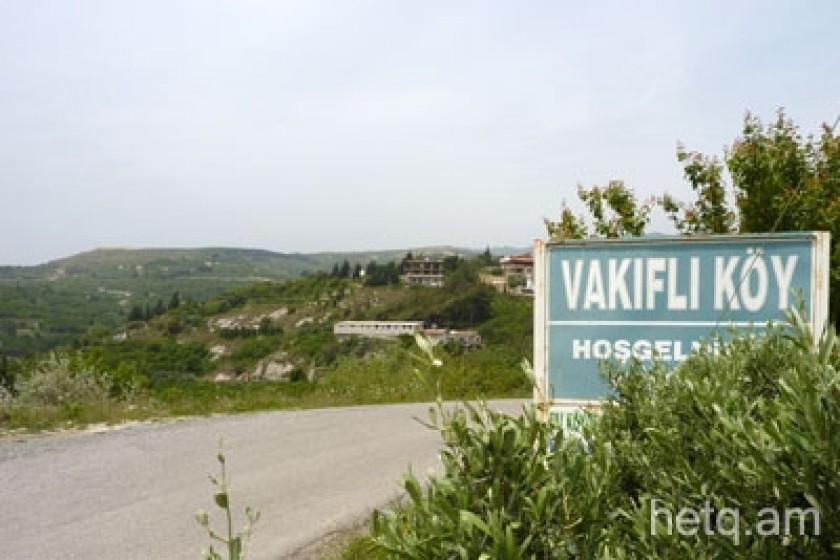
Vakif: Last Surviving Musa Ler Village Faces Uncertain Future
Where are those Armenians demanding “our lands, our lands”?
Some 25 kilometers from Antakya, on the southern slopes of Musa Ler, stands Vakif, the last remaining Armenian village in all Turkey. Ironically, the name in Turkish means “collaboration.
Our bus stopped at the approach to the village. The Mediterranean Sea is in the background and the Syrian border isn’t far away. There, you find another historic oddity of sorts, the Armenian village of Kessab, another remnant of the Armenian Kingdom of Cilicia that has survived till today.
Vakif is the only one of the seven villages of Musa Ler that has survived. We all know the story – the historic resistance of 1915, the French boats taking Armenian villagers to points south (Port Said, later Beirut), the return of many after Hatay (Alexandretta) was declared a French mandate in 1918, and then, the final blow in 1938 when Turkey annexed the district from Syria with French complicity.
After this move the other six Armenian villages immigrated out of Hatay settling in Lebanon's Beqaa Valley, especially Anjar, while the residents of Vakif chose to stay. They were joined by some Armenian residents of the other villages.
Today, there are 135 Armenians living in Vakif; 35 households. A majority are senior citizens. The young people leave for Istanbul to study. Most don’t return. In fact many residents spend the winter in Istanbul as well, returning to the village in the summer months.
The St. Astvatzatzin Armenian Apostolic Church stands at the entrance to the village. It was there that I met with Talin Kartoun, who serves on the church board. I was amazed to hear her speak perfect eastern Armenian even though she was born in Vakif.
 When she was eight, the family relocated to Armenia. She lived in Armenia for 16 years before returning to the village to see her grandparents. Talin got married and stayed.
When she was eight, the family relocated to Armenia. She lived in Armenia for 16 years before returning to the village to see her grandparents. Talin got married and stayed.
St. Astvatzatzin (Holy Mother of God) was built in 1890, but only started to operate as a church in 1924. Renovated in 1997, the church has no permanent pastor, except for the summer months when the population swells. One has to be called in from Istanbul. I was told that a permanent clergyman would be appointed this summer.
Talin told me that 3,000-4,000 Armenians converge on the tiny village for the summer holiday of the Virgin Mary. “It’s also great for the kids because they can practice their Armenian,” Talin said.
Eliza, Talin’s daughter, approached us. Talin told the girl to say “hello”. The girl repeated the word seemingly from rote. While Eliza can understand some Armenian she finds it hard to converse. There are 25 children in the village. In the summer when the Armenian pastor arrives, the kids assemble in the church for Armenian lessons. There is no regular school in Vakif. The children travel to a Turkish school in a neighboring village.
“Our kids can recite the prayers in the liturgy. They learnt by Turkish letters and our on Musa Ler dialect,” Talin said. “They study the Armenian alphabet but quickly forget. There’s practically no cultural life in the village, just a singing group for the kids.”
I walked to the village cemetery and sae that a new grave had been dug. Vakif Mayor Berj Kartoun said that the village death rate outstrip the birth rate many times. There hasn’t been a birth here in two years. Just last week there were two deaths. The young people don’t marry in the village. They go to Istanbul and don’t return.
When I asked if residents had preserved the old traditions of an Armenian wedding, Talin laughed and said that they hadn’t seen a wedding in a long time. Berj couldn’t even remember the last time for sure. “Must have been five years ago,” he said, and confessed that all the songs were in Turkish.
Mayor Berj said that there was a 10% rate of people leaving the village; a trend which started ten years ago.
Residents told me that the government paid attention to improving conditions in the village and that the roads had recently been repaired.
“We’re pretty comfortable here. They want to show the world that Armenians are well looked after here in Turkey. We get lots of tourists as well,” Talin said.
Walking around, I noticed the abundance of orange trees in the gardens. The fruit is a staple ware for residents. There were only a few cows grazing about. Neighboring Turkish villages are more engaged in livestock.
After lacework, for which the women of Vakif are famous, various types of fruit drinks and preserves are also sold at a store near the church. “There’s no chemicals. It’s all organic,” boasted Gohar Kartoun at the store.
The oldest Vakif resident is 97 year-old Avetis Demirji, a village native. He speaks perfect Armenian and is proud of the fact. Grandpa Avetis warmly greeted us as we approached him seated on the couch. He can’t walk on his own and spends much of the day outside on the porch.
He doesn’t have any memories of 1915, being just one at the time. What he can relate when told to him by his parents and relatives. Like many others, his family wound up in Egypt and returned to Vakif in 1918.
As we left Vakif, we were escorted by Grandpa Avetis’ son who picked oranges off the tree for us.
“These are Armenian oranges, nice and juicy. Enjoy them on the road back.”
 Videos
Videos Photos
Photos
Comments (5)
Write a comment